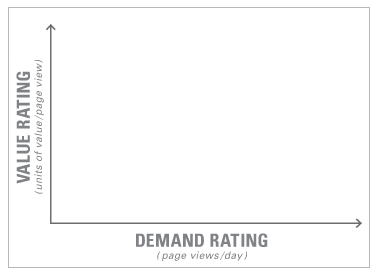In subscriptions, how can a sales manager differentiate the up-sell vs. the retention risk between two customers with same number of page views and visits?
Value Rating is the answer, or the percentage of page views that are units of value (full description of Value Rating in Part 1 of series). Using Value Rating as a metric, Scout Analytics has found that categorizing engagement on page views alone, will incorrectly classify the revenue opportunity of 15 percent of customers. The consequence of using page views as a primary metric is that sales managers will use wrong negotiation tactic with customers 15 percent of the time.
Chart 1 to the right will help illustrate the limitations of page views only. The horizontal axis of the chart is the Demand Rating for a customer (i.e., average page views per day). The vertical axis is the Value Rating for the customer. The intersection of Value Rating and Demand Rating will highlight the difference in value between customers having the same number of page views.
horizontal axis of the chart is the Demand Rating for a customer (i.e., average page views per day). The vertical axis is the Value Rating for the customer. The intersection of Value Rating and Demand Rating will highlight the difference in value between customers having the same number of page views.
Chart 2 shows a typical distribution for customers of a paid content service. For any given level of engagement, there is a range of value extracted from the service. In particular, the median level engagement sees a significant difference in value. Some customers’ page views are more than 80 percent units of value while others are less than 10 percent.
In Chart 2, notice how the customers with the highest demand converge on a narrow band of units of value. Given that these high demand customers typically represent the most advanced use, their score typically represents the median Value Rating. Using their score as the median (and with a bit more number crunching), it is easy to identify where the customers are that are getting great value (i.e., increased up-sell potential) and those that are not getting great value (i.e., increased retention risk).
Chart 3 shows the segmentation by Value Rating. This chart shows exactly why page views alone do not provide adequate insight especially with customers above the median number of page views. As the chart shows, some customers in red are above the median page views, but have a low Value Rating. By detecting this early, a sales manager can arrange appropriate training or entitlement changes to increase value received and capitalize on customer engagement. The customers in green are getting more value than their peers at the same level. These are the customers that sales teams can focus up-sell and cross-sell strategies to grow revenue. These two segments are usually 15% of the customers.
As Chart 3 shows, the disparity in how customers use a paid-content service can distort the value they are receiving. Understanding Value Rating, digs deeper into page views to understand the true value a customer is receiving, providing intelligence that can be used to maximize revenue.






